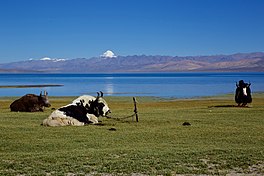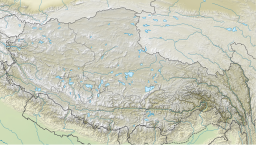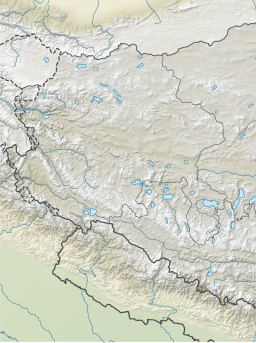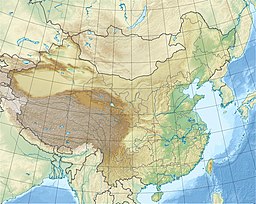Lake Manasarovar (Sanskrit: मानसरोवर, romanized: Mānasarōvar), also called Mapam Yumtso (Tibetan: མ་ཕམ་གཡུ་མཚོ།, Wylie: ma pham g.yu mtsho, THL: ma pam yu tso; Chinese: 瑪旁雍錯; pinyin: Mǎ páng yōng cuò) locally,[a] is a high altitude freshwater lake near Mount Kailash in Burang County, Ngari Prefecture, Tibet Autonomous Region, China. It is located at an elevation of 4,600 m (15,100 ft), near the trijunction between China, India and Nepal. It overflows into the adjacent salt-water lake of Rakshastal via the Ganga Chhu. The sources of four rivers: Indus, Sutlej, Brahmaputra, and Karnali lie in the vicinity of the region.
| Lake Mansarovar | |
|---|---|
| Mapam Yumtso (Standard Tibetan) | |
 Lake Manasarovar with Mount Kailash in the background | |
| Location | Burang County, Ngari Prefecture, Tibet Autonomous Region, China |
| Coordinates | 30°39′N 81°27′E / 30.65°N 81.45°E |
| Surface area | 320 km2 (120 sq mi) |
| Max. depth | 100 m (330 ft) |
| Surface elevation | 4,600 m (15,100 ft) |
| Frozen | Winter |
The lake is sacred in Hinduism, Buddhism, Jainism and Bon religion. People from India, China, Nepal and other countries in the region undertake a pilgrimage to the region. The pilgrimage generally involves trekking towards Lake Mansarovar and a circumambulation of the nearby Mount Kailash.
Etymology
editThe Sanskrit word "Mansarovar" (मानसरोवर) is a combination of two Sanskrit words, Mānas (मानस्) meaning "mind" (generally denotes the mental powers associated including intellect, perception, conscience)[3] and sarovar (सरोवर) meaning "lake or a large pond".[4] The lake is called as Mapam Yumtso (Tibetan: མ་ཕམ་གཡུ་མཚོ།, Wylie: ma pham g.yu mtsho, THL: ma pam yu tso; Chinese: 瑪旁雍錯; pinyin: Mǎ páng yōng cuò) and Tso Madröpa locally. In his Tibetan-English dictionary, Sarat Chandra Das states that Mapam Yumtso is derived from Mapam meaning unconquerable or invincible and Tso Madröpa is derived from Madropa meaning "ground heated by the Sun" both used in combination with Tso, the Tibetan word for lake.[5]
Geography
editLake Manasarovar is located in Ngari Prefecture, Tibet Autonomous Region of China.[6][7] It is located in the southwest region of Tibet north of the western tripoint of the border between China, India and Nepal.[8] It is visible from the Lapcha La pass above the Limi valley in Nepal on a clear day.[9] The freshwater lake lies at 4,600 m (15,100 ft) above mean sea level on the mostly saline lake-studded Tibetan Plateau and is one of the highest freshwater lakes in Asia.[6][10][11]
Spread over a surface area of 320 km2 (120 sq mi), Lake Manasarovar is relatively round in shape with a circumference of 88 km (55 mi) and a maximum depth of 100 m (330 ft).[12] Manasarovar overflows into the salt-water endorheic lake of Rakshastal via the natural Ganga Chhu channel.[10][13][14] The major rivers rising from the region include Yarlung Tsangpo (which becomes the Brahmaputra), the Indus, the Sutlej and the Karnali, a tributary of Ganges.[15][16]
Climate
editThe weather is fairly dry during April to June with day time temperatures of more than 5 °C (41 °F) and night time temperatures close to 0 °C (32 °F). The temperature starts to decrease in October with January being the coldest. Winters have day time temperatures below freezing with colder nights.[17] Monsoons bring rain from late June to August with cold winds.[18]
Global warming is described as happening rapidly on the Tibetan Plateau than anywhere else in the world.[19][20] According to locals, the land around the region has been growing warmer in recent years with winters not as cold as it used to be.[21] The retreating glaciers and thawing of the permafrost in the Tibet region might lead to uncertain effects on water resources of the region. These effects along with population explosion and tourism has put severe stress on the fragile ecosystem.[22][23]
| Climate data for Lake Manasarovar | |||||||||||||
|---|---|---|---|---|---|---|---|---|---|---|---|---|---|
| Month | Jan | Feb | Mar | Apr | May | Jun | Jul | Aug | Sep | Oct | Nov | Dec | Year |
| Mean daily maximum °C (°F) | −3.2 (26.2) |
−2.0 (28.4) |
0.9 (33.6) |
6.4 (43.5) |
10.2 (50.4) |
13.7 (56.7) |
13.7 (56.7) |
13.1 (55.6) |
13.1 (55.6) |
11.1 (52.0) |
6.5 (43.7) |
1.0 (33.8) |
7.0 (44.7) |
| Daily mean °C (°F) | −8.9 (16.0) |
−7.6 (18.3) |
−4.2 (24.4) |
−0.1 (31.8) |
3.1 (37.6) |
7.1 (44.8) |
8.4 (47.1) |
8.0 (46.4) |
8.0 (46.4) |
5.4 (41.7) |
−0.2 (31.6) |
−5.1 (22.8) |
1.2 (34.1) |
| Mean daily minimum °C (°F) | −14.5 (5.9) |
−13.1 (8.4) |
−9.2 (15.4) |
−6.6 (20.1) |
−4.0 (24.8) |
0.6 (33.1) |
3.1 (37.6) |
3.0 (37.4) |
−0.2 (31.6) |
−6.8 (19.8) |
−11.1 (12.0) |
−13.3 (8.1) |
−6.0 (21.2) |
| Average precipitation mm (inches) | 52 (2.0) |
34 (1.3) |
52 (2.0) |
30 (1.2) |
26 (1.0) |
40 (1.6) |
125 (4.9) |
135 (5.3) |
66 (2.6) |
29 (1.1) |
7 (0.3) |
18 (0.7) |
614 (24) |
| Source: Climate-Data.org | |||||||||||||
History and texts
editThere is no mention of the lake (or its location) in Vedic literature or ancient Sanskrit and Prakrit texts. Though colonial era and modern texts state Manasarovar to be among the most sacred sites of Indian religions, particularly Hinduism, this status is not found in early Indian texts prior to texts authored in the 1st millennium CE.[24][25] Instead, the early Buddhist, Hindu and Jain texts mention a mythical Mount Meru and Lake Manasa. The mythical Manasa lake is described as one created through the mind of Brahma as the preferred abode of his vahana hamsa.[26]
While there is no explicit mention of this lake or the nearby mountain in ancient Sanskrit texts, there is indirect mention of this region of Tibet in hymn 2.15 of the Rigveda. There it says that the Indus River keeps flowing north because of Indra's power, a geographical reality only in Tibet. This is in the context of Himavant (or the Himalayas). According to Frits Staal, a Sanskrit and Vedic studies scholar, this makes it likely that some among the ancient Vedic people traced the Indus river route and had seen the valley near Mount Kailash. However, there is no mention of this lake or it being a tirtha (pilgrimage site).[25]
Typically, major historic pilgrimage sites that were frequented by Buddhists, Hindus and Jains attracted discussion in their respective texts and the construction of infrastructure by wealthy patrons or kings. In Hinduism, these are the mahatmya chapters in the Puranas, and the infrastructure includes temples, dharmasalas, ashrams and pilgrimage facilities. At least until the 1930s, there was no evidence of such structures in the Kailash-Manasarovar region.[25]
The earliest verifiable reports that confirm that this lake site attracted pilgrims are those of the Buddhists. According to Luciano Petech, Tibetan records confirm that Buddhists considered the region now identified as Kailasa and Manasarovar to be their sacred geography by the late 12th-century, with many reports of Buddhist monks meditating in the Go-zul cave of Kailash and circumambulating the mountain.
According to Alex McKay, the possible synthesis of esoteric Buddhism and Shaivism in Nepal, Tibet and eastern region of India may have expanded and brought Kailash and lake Manasarovar into the shared sacred geography for both Buddhists and Hindus. The 13th-century text Mahanirvana Tantra dedicates it first chapter to Kailash and Manasarovar lake as a pilgrimage site. This may have been coupled with the re-discovery of its importance to major rivers on the subcontinent.[27]
Between 1901 and 1905, southern Tibet became strategically important to the British Empire. The colonial era officials decided to encourage and assist religious pilgrimage to this lake and Kailash with comments such as "a devotee will be the pioneer of trade". By 1907, about 150 pilgrims a year visited this site, a number significantly higher than those in the 19th century. The number of Indian pilgrims grew to 730 by 1930. Pilgrimage road and facilities to this lake and Kailash were constructed by Indians, in cooperation with Tibetan monks and officials, along the route after 1930.[28]
Religious significance
editIn Hinduism
editLake Manasarovar and Mount Kailash are believed to be the abode of Shiva. This is where the holy river the Ganges is believed to be tamed by Shiva and sent to nourish the fertile valleys below the Himalayas. It is sometimes conflated with Meru.[10] For the Khas, Hindu shamans of the nearby region of Humla (northwest Nepal), a ritual bath in Lake Manasarovar is an important step in gaining their shamanic powers.[29]
In the Bon religion
editThe Bon religion is also associated with the holy place of Zhang Zhung Meri sacred deity. When Tonpa Shenrab, the founder of the Bon religion, visited Tibet for the first time and bathed in the lake.
In Buddhism
editBuddhists associate the lake as the mother principle, with Kailash as the father principle. The Yamantaka shrine here is one of the eight guardian deities, who is shown in the act of a sexual embrace to unite compassion and wisdom. A traditional 32-mile circuit around the mountain, called kora, is believed to be a particularly holy walk.[10] According to legend, Queen Maya bathed at Manasarovar before she gave birth to Buddha.[30]
The lake has a few monasteries on its shores, the most notable of which is the ancient Chiu Monastery built on a steep hill, looking as if it has been carved right out of the rock.
In Jainism
editIn Jainism, Lake Manasarovar is associated with the first Tirthankara, Rishabha.[10] As per Jain scriptures, the first Tirthankar, Bhagwan Rishabhdev, had attained nirvana on the Ashtapad Mountain. The son of Bhagwan Rishabhdev, Chakravati Bharat, had built a palace adorned with gems on the Ashtapad Mountain located in the Himalayas. There are many stories related to Ashtapad Maha Tirth like Kumar and Sagar's sons, Tapas Kher Parna, Ravan and Mandodri Bhakti, among many others.[31]
Gallery
edit-
The trail to Manasarovar lake
-
Small temples and stupa near the lake
-
Buddhist Prayer flags on the shore
-
Monuments and Mount Kailash near the lake
-
Mount Kailash sunset
See also
editNotes
editReferences
edit- ^ "Geographical names of Tibet AR (China): Ngari prefecture". KNAB Place Name Database. Institute of the Estonian Language. 3 June 2018.
- ^ McKay, Alex (2013). Pilgrimage in Tibet. Routledge. p. 26. ISBN 978-1-13680-709-1.
- ^ "Monier-Williams Sanskrit-English Dictionary". Monier-Williams. Archived from the original on 3 December 2012. Retrieved 10 October 2017.
mánas n. mind (in its widest sense as applied to all the mental powers), intellect, intelligence, understanding, perception, sense, conscience
- ^ "Monier-Williams Sanskrit-English Dictionary". Monier-Williams. Archived from the original on 20 May 2015. Retrieved 10 October 2017.
sarovara ○vara n. (accord. to some also m.) a lake or large pond, any piece of water deep enough for the lotus
- ^ Das, Sarat Chandra (1902). Tibetan-English Dictionary with Sanskrit Synonyms. Bengal Secretariat Book Depot. p. 658, 959.
- ^ a b "Mount Kailas". Britannica. Retrieved 1 December 2023.
- ^ Samkar, Nyima (2020). Mount Kailash: the White Mirror. Library of Tibetan Works and Archives. p. 3. ISBN 978-9-38702-385-7.
- ^ Claude Arpi (23 February 2024). "China playing new border games close to Mt Kailash". Deccan Chronicle. Archived from the original on 28 February 2024. Retrieved 1 March 2024.
- ^ "Limi-Lapcha could be an alternative route to Kailash Manasarovar". The Himalayan Times. 13 March 2021. Archived from the original on 28 May 2022. Retrieved 9 August 2022.
- ^ a b c d e Brockman, Norbert (2011). Encyclopedia of Sacred Places, Volume 1. ABC-Clio. p. 356. ISBN 978-1-59884-654-6.
- ^ Likens, Gene (2009). Encyclopedia of Inland Waters. Elsevier Science. p. 505. ISBN 978-0-12370-626-3.
- ^ "Lake Mansarovar". Government of Uttarakhand. Retrieved 1 June 2024.
- ^ Likens, Gene (2010). Lake Ecosystem Ecology: A Global Perspective. Elsevier Science. p. 294. ISBN 978-0-12382-003-7.
- ^ John Vincent Bellezza (2024). A Comprehensive Survey of Rock Art in Upper Tibet: Volume III. Archaeopress. ISBN 978-1-80327-774-5.
- ^ Freeman Attwood (2003). "Gangdise Mountains" (PDF). Alpine Journal. 4: 103–109. Archived (PDF) from the original on 13 November 2022. Retrieved 17 March 2024.
- ^ Singh, Dhruv Sen. The Indian Rivers: Scientific and Socio-economic Aspects. Springer Publishing. p. 15. ISBN 978-9-81102-984-4.
- ^ "Tibet Weather". Tibet tour. Retrieved 1 June 2024.
- ^ Kailash Yatra (PDF) (Report). Government of India. 12 May 2006. p. 60. Retrieved 1 June 2024.
- ^ Qiu, Jane (1 July 2008). "China: The third pole". Nature. 454 (7203): 393–396. Bibcode:2008Natur.454..393Q. doi:10.1038/454393a. ISSN 1476-4687. PMID 18650887.
- ^ "The world has a third pole – and it's melting quickly". The Guardian. 15 September 2019. Retrieved 1 June 2024.
- ^ "Ignoring climate change in the Himalayas". The Third Pole. 9 January 2019. Archived from the original on 6 August 2022. Retrieved 6 August 2022.
- ^ Tanguang Gao (23 April 2021). "Accelerating permafrost collapse on the eastern Tibetan Plateau". Environmental Research Letters. 16 (5). Bibcode:2021ERL....16e4023G. doi:10.1088/1748-9326/abf7f0.
- ^ Kailash Sacred Landscape Conservation Initiative: Feasibility Assessment Report (Report). ICIMOD. 22 June 2009. p. 4. Retrieved 1 June 2024.
- ^ Alex McKay (2015), Kailas Histories, Brill Academic, pp. 375–379 with footnotes
- ^ a b c Alex McKay (2013). Pilgrimage in Tibet. Taylor and Francis, ISBN 9781315027180, pp. 165–168
- ^ Eckard Schleberger, Die Indische Götterwelt. Eugen Diederich Verlag. 1997 (in German)
- ^ Alex McKay (2013). Pilgrimage in Tibet. Taylor and Francis, ISBN 9781315027180, pp. 175–176
- ^ Alex McKay (2013). Pilgrimage in Tibet. Taylor and Francis, ISBN 9781315027180, pp. 177–181
- ^ Bubriski, Kevin; Pandey, Abhimanyu (2018). Kailash Yatra: a Long Walk to Mt Kailash through Humla. New Delhi: Penguin Random House. p. 33. ISBN 978-0670091119.
- ^ Mayhew, Bradley; Kelly, Robert (2015). Lonely Planet Tibet. Lonely Planet. ISBN 9781743604984.
- ^ "'Lost' tirth of Jains traced to Himalayas - Latest News & Updates at Daily News & Analysis". dnaindia.com. 30 December 2011. Archived from the original on 15 August 2017. Retrieved 29 April 2018.
External links
edit- Mount_Kailash travel guide from Wikivoyage


